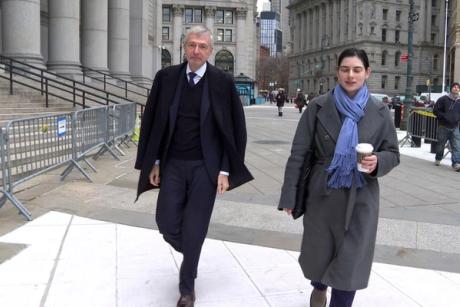
Exactly three weeks after the civil fraud trial between Sotheby’s and the Russian billionaire Dmitry Rybolovlev kicked off in a Manhattan courtroom, the lawyers for both sides delivered their closing arguments today (29 January). The two summations, which clocked in at around two and a half hours apiece, told two largely different stories about the facts of the case and the culpability of its various characters. Which one will win out, however, remains an open question for at least one more night.The day’s proceedings brought the protagonists in this drama near the end of a long, winding road. Between 2003 and 2014, Rybolovlev paid roughly $2bn to acquire 38 works of art through the Swiss businessman Yves Bouvier. (The actual buyer in all cases was one of two offshore trusts, Accent Delight International and Xitrans Finance , technically the two plaintiffs in the present lawsuit.) Over time, however, Rybolovlev learned that Bouvier, whom the Russian thought he had contracted to act as an agent on his behalf, had instead acquired and resold these works to his trusts at markups he alleges total more than $1bn.Among those 38 works were 13 that Bouvier bought in private transactions with Sotheby’s. Pretrial rulings winnowed Rybolovlev’s case against the house down to just four works. The most prominent of these is the Salvator Mundi (around 1500), controversially reattributed to Leonardo da Vinci, followed by Gustav Klimt’s 1907 canvas Wasserschlangen II (Water serpents II), Rene Magritte’s Le Domaine d’Arnheim (1938) and the Amedeo Modigliani sculpture Tête (Head).After pursuing civil and criminal charges against Bouvier in territories ranging from Switzerland and Monaco to Hong Kong and Singapore, Rybolovlev settled all matters with Bouvier in all jurisdictions in December 2023. This decision leaves the civil trial against Sotheby’s as perhaps Rybolovlev’s final chance for compensation—and today’s proceedings as his lawyers’ final chance to convince the jury to award it to him. (Bouvier has maintained from the start that Rybolovlev knew him to be acting as a dealer free to set his own prices; he has never been convicted of any crime anywhere.)‘In on the con’Zoe Salzman, who handled the closing argument for Rybolovlev’s side, mainly shaped her summation around two prongs. The first was that Samuel Valette, Sotheby’s worldwide chairman of private sales and Bouvier’s main point of contact at the auction house, was “in on the con” allegedly perpetrated against the Russian; the second was that Sotheby’s senior leadership repeatedly looked the other way in regard to Valette’s purportedly illicit dealings with Bouvier, precisely because those dealings had become too lucrative for the auction house to risk slowing down or snuffing out through meaningful oversight.To this second point, Salzman said: “They [Sotheby’s] had a lot of policies on the books, but they didn’t do anything to enforce them.” In particular, she portrayed the house’s appraisal criteria—a frequent point of contention throughout the case, especially in the case of the Salvator Mundi—as functioning less like meaningful internal regulations and “more like optional guidelines”.This allegation echoed Rybolovlev’s contention that what led him to ruin was the opacity of the art market, with Sotheby’s as one of the chief obfuscators. Salzman called back to her client’s testimony regarding why he filed this complaint against the auction house in the first place: “It’s not only a matter of money. It’s important for the art market to be more transparent, because as I’ve already mentioned, when the largest company in this industry [Sotheby’s] is involved in actions of this sort, clients don’t stand a chance.”Sotheby’s role in the private sale of the Salvator Mundi (around 1500), re-attributed to Leonardo da Vinci, plays a central role in the trial against Dmitry Rybolovlev.Image is public domain sourced / access rights from The Picture Art Collection / Alamy Stock PhotoSalzman also split several of the current and former Sotheby’s employees who testified in the case into three categories: those who were basically honest professionals doing their jobs honourably, such as co-chair of Old Masters Alexander Bell and former head of valuations Franka Haiderer; those whose worst alleged misdeed was to steer clear of any information that could constrain the house’s profits, such as former chief executive William Ruprecht and former chief operating officer Bruno Vinciguerra; and in a class of his own, Valette, who she portrayed as having been “in Bouvier’s pocket” for years.Yet in the end, Salzman argued, the distinctions between these groups were essentially irrelevant. It was the responsibility of Sotheby’s, as a global corporation, to implement internal regulations that would justify its sterling reputation in the art market, as well as to monitor its staff to ensure those regulations were followed in all its departments and offices worldwide. In her telling, the evidence showed this did not happen, whether it came to assessments of fair market value for the Magritte and Modigliani works, the authenticity and condition of Salvator Mundi or Valette’s role as the “key client manager” assigned to Rybolovlev.“Sotheby’s sells trust. You can’t blame Mr. Rybolovlev for buying it,” she said to the jury, adding that this was precisely what Sotheby’s lawyers were trying to persuade them to do. Instead, she proposed an alternative.“It’s time for you to tell Sotheby’s that big companies are still accountable under the law,” she said, adding in conclusion: “The buck stops now. The buck stops with Sotheby’s.”‘Bouvier is not here’After a lunch break, it came time for Marcus Asner, Sotheby’s lead counsel, to make his final appeal to the jury. Rather than immediately contesting the plaintiff’s case, he began on a point of convergence between the two sides.“There’s one thing we agree about: Bouvier lied to Mr. Rybolovlev repeatedly,” Asner said. “If there’s a fraud here,” he added, “that’s where it was.”“But Bouvier is not here,” he continued, referring to the fact that Bouvier was not a party to the lawsuit. Instead, Asner alleged, Rybolovlev had decided to sue Sotheby’s in an attempt to “make somebody else pay for what happened to him”.Then the lawyer pivoted to a war footing. He portrayed Salzman’s closing argument again and again as “mud thrown on the wall” to distract from the fundamental issues of the case, which he largely distilled into two points.First, he argued, there was “zero evidence that Sotheby’s knew anything about Bouvier’s lies”. The auction house was aware from the start that Bouvier was a dealer, partly because he had conducted scores of transactions with Sotheby’s over the years. This meant that Valette and others always knew that any information they sent to Bouvier could be used in his subsequent efforts to flip works to someone else.But there was nothing wrong with that, Asner argued; it is simply how markets work, including the market for art. Just as important, Sotheby’s made no money whatsoever from Bouvier’s resales, whether the end client was Rybolovlev or anyone else. This gave the house no incentive to assist him in artificially inflating his own resale prices.In fact, Valette testified that, in his first transaction with Bouvier, the latter was “very clear” that the sale contract should be drawn up with Blancaflor Investments, one of the companies Bouvier used to buy art (including some of the works he would later resell to Rybolovlev), which “was buying this work as a principal”—that is, an end buyer—rather than as an intermediary. This became the arrangement whenever Bouvier did business with Sotheby’s thereafter.This point also led to one of the harder-hitting moments of Asner’s summation: Rybolovlev acquired 23 works of art from Bouvier before Sotheby’s was ever involved, suggesting that Bouvier did not, in fact, need any assistance from the auction house in convincing Rybolovlev to pay his prices. This idea undercut the plaintiff’s contention that it was Sotheby’s, and Sotheby’s alone, that enabled Bouvier’s markups.The second pillar of Asner’s closing argument revolved around a legal concept called “reasonable reliance”, which effectively asks whether it was reasonable for a party alleging fraud (in this case, Rybolovlev) to have trusted the accused fraudster (Bouvier) in light of the available evidence. Asner argued that, here, it was not—and since it was not reasonable for Rybolovlev to have trusted Bouvier in the first place, then from a legal standpoint, no fraud actually occurred, clearing Sotheby’s of even the potential for wrongdoing.“These are not children,” Asner said of Rybolovlev and Mikhail Sazonov, who led Rybolovlev’s family trusts for more than 15 years, before putting bulleted lists of the two men’s extensive educational and business credentials onscreen for the jury. Instead, he continued, they are “sophisticated businessmen” who “surrounded themselves with lawyers and accountants at every turn”, except when it came to doing nearly all of their deals with Bouvier. (Notably, Rybolovlev enlisted a major Swiss law firm to execute sales contracts for the first four works he acquired through Bouvier but then stopped.)To further support this point, Asner returned to testimony by Sazonov in which he recalled that Bouvier had told him and Rybolovlev that every other intermediary in the art market was crooked; only Bouvier could be trusted. Sazonov and Rybolovlev’s actions suggest they took this grandiose statement at face value. Both men admitted on the witness stand that they never asked to see any sales contracts with the sellers of the works acquired by Accent Delight and Xitrans, and Rybolovlev never checked to see if Sazonov had indeed executed a contract with Bouvier to act as his agent. At least, not until after he had spent $2bn.Asner reached the summit of this approach when he called back to the negotiations for the Salvator Mundi. At one point, Bouvier proposed a strategy to deflate the painting’s price and “break the morale” of the sellers by falsely claiming his then-unidentified Russian client was no longer interested. Rybolovlev did not stop Bouvier from using this tactic, casting doubt on the former’s contention on the witness stand that he sued Sotheby’s in part to shine a light on the art market’s dark dealings.By taking part in this ruse, Asner argued, Rybolovlev and Sazonov destroyed any claim to reasonable reliance they might have had: “They’re playing with a con man, they know they’re playing with a con man and they got conned.”We will soon find out whether the six jurors agree. Tomorrow (30 January), Judge Jesse Furman will instruct them about the parameters of their pending decision before sending them off to deliberate in private. The art trade will anxiously await their verdict.


























